

Table of contents
- Different material variants
- Optimum number and size
- Suitable location
- Ideal base for a compost bin
- Start composting properly
- That can end up on the compost heap
- This doesn't belong in the compost bin
- Different shifts
- Shred big chunks
- accelerate the rotting process
- Turn over compost heaps
- The right time to convert
- More tips about composting
In the perfectly organized nature nothing is wasted. The building blocks of life are constantly being reassembled by her. Anyone can take advantage of that. Especially every garden owner. Add vegetable waste to the compost heap. Get back fine and nutrient-rich soil. That's how easy it is to save money on more expensive fertilizer. Find out what else you need to know about composting here.
Different material variants
Wood, metal and plastic are the three main materials used to make compost bins. The individual materials differ greatly in their properties. Decide for yourself which variant you prefer.
- a wooden compost bin looks natural
- However, wooden slats will rot over time
- Slats occasionally need to be replaced
- Metal grilles are more durable
- a coating protects against rust
- Plastic thermal composters speed up the rotting process
- small models fit in every garden
- Plastic doesn't look particularly appealing
Tip:
Skilled craftsmen can also wall a compost container firmly. Special bricks are offered in hardware stores that ensure adequate ventilation.
Optimum number and size
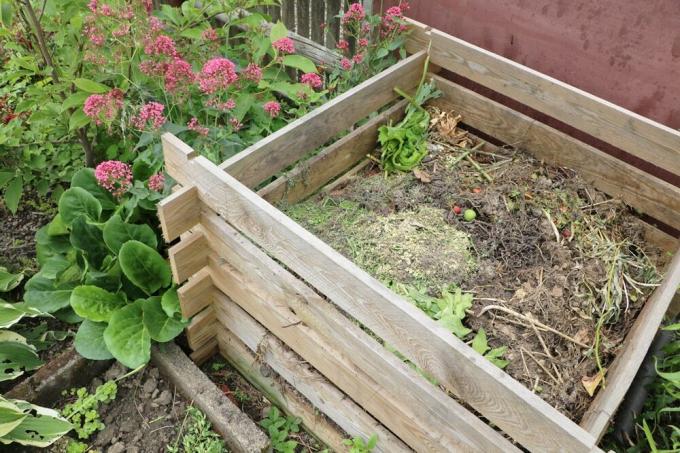
The rotting process in a compost heap is promoted by turning. This work is easiest to carry out when there are several compost bins in a garden at the same time. In addition, there should always be free capacity to accommodate all plant waste that is constantly occurring. A number of three containers has proven to be optimal. A compost bin itself is well dimensioned at about one cubic meter. Length, height and depth are then each one meter.
Suitable location
Sun, wind and rain affect the compost heap, changing temperature and humidity. This is quite helpful for the work of the microorganisms. But the compost heap as a "living system" does not like extremes in this regard. Depending on the weather, rotting or dehydration can quickly occur. The orderly conversion process comes to a standstill. A location that lets him feel the unpredictable weather to a lesser extent is ideal:
- no continuous blazing sun
- no total shadow
- Half shade is ideal
- House wall, garden hedge or a tall tree offer protection
- Sheltered from the wind, but not windless
- because enough fresh air is necessary
Tip:
Compost bins are often placed at the edge of the property. Nothing speaks against it either. However, in the spirit of good neighborliness, you should keep an appropriate distance from the property line.
Ideal base for a compost bin
When the compost bin is set up, care must be taken to give the microorganisms free access. They are the crucial factor in the decomposition work and must be able to find their way into the container quickly and easily. This only works if the compost bin is directly on the ground. For example, earthworms from the garden can migrate deep into the interior of the compost. Sealed surfaces such as concrete, stone or asphalt are not suitable for setting up a composter as they prevent direct contact with the living soil.
Start composting properly
First, the ground under the compost bin should be loosened with a digging fork. Then the coarse plant material comes in first. Small cut twigs and chopped branches are optimal for this layer. It should be a maximum of 20 cm high. Only then do the finer substances, such as vegetable and fruit waste, follow. The more diverse the plant remains, the better.
That can end up on the compost heap
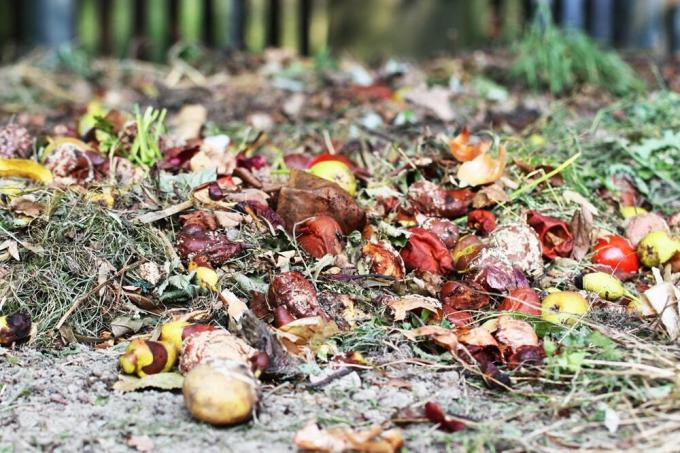
Not everything of plant origin is safe in a compost heap. Below is a brief overview of what can go into the compost without hesitation.
- raw fruit and vegetable waste
- Tea bags and coffee filters including coffee
- eggshells
- Lawn clippings, dried and in small quantities
- shrub and tree pruning
- litter and straw
- leaves
- sawdust
Tip:
The Federal Environment Agency offers the free brochure “Compost Guide” on its website. It contains a lot of information that makes composting understandable and easier.
This doesn't belong in the compost bin
Everything that does not come from a plant cannot and must not be composted. There are also plant residues that are very difficult to decompose. Even cooked vegetables or fruits have no place on the compost heap. Here are a few examples to clarify:
- plastic
- Glass
- metal
- cat litter
- ash
- cooked leftovers
- non-vegetable leftovers
- Citrus fruits in large quantities
- diseased plant parts
- conifers
Tip:
Caution is also required with weeds weeded. Ripe seeds can survive the conversion process in the compost intact. As soon as the mature compost is distributed in the garden, new weeds will sprout from it.
Different shifts
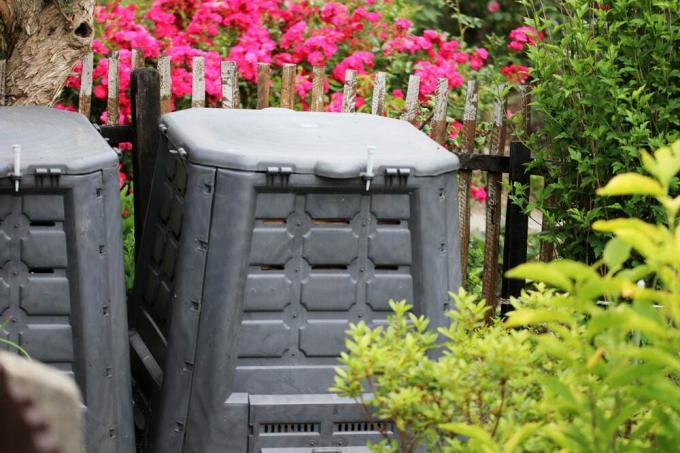
Not only the content is decisive, the quantity and the composition also play an important role. Diversity in the starting material is helpful for the composting process to run smoothly.
- various components are beneficial
- dry and wet material should alternate
- as well as coarse and fine plant remains
- individual component shouldn't go into it in bulk at once
- at most one 20 cm layer of one component is allowed
- this should be followed by a different type of plant material
Oak leaves and walnut leaves rot very slowly. They should not be composted at all or only in small amounts.
Shred big chunks
The plant material that accumulates in the garden is often a challenge for the decomposing microorganisms. At least if it ends up in the compost without being processed first. Twigs, branches and stems are simply an enormously large portion that takes a long time to decompose. It goes much faster if hard and bulky plant material is divided into smaller pieces beforehand.
- Cut small amounts with garden shears
- after cutting trees and bushes, a lot accumulates
- a shredder is helpful here.
Tip:
Again, only a limited amount of this waste component should be added to the compost heap at one time. If there is a lot of shredded wood material, it can also be spread under trees and bushes.
accelerate the rotting process
Impatient gardeners like to give their compost heap a helping hand so that it provides them with fine compost as soon as possible. In order to significantly shorten the decomposition time, the following means are often used:
- commercially available compost accelerator
- so-called compost starter
- lime
- rock flour
- bacterial preparations
These funds all cost money that does not necessarily have to be spent. A well-mixed compost heap contains coarse and hard as well as fine and soft matter. This is enough for a smooth decomposition. If you still want to gain some time, you can do so with a few simple tools that are available free of charge in the garden. The following additions also have an accelerating effect.
- mature compost
- coarse sieved compost
- garden soil
A few scoops of it contain enough microorganisms that start as a kind of vaccination and diligently continue to multiply in the compost.
Turn over compost heaps
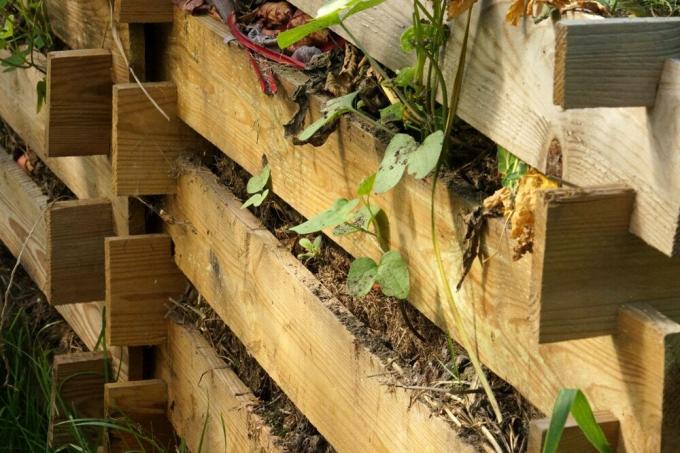
A compost heap is constantly changing. Old material gradually decomposes, new plant material is constantly being added. Over time, it grows to a formidable mountain. Now ventilation can no longer be uniform everywhere. Turning the compost heap has two advantages:
- the compost is aerated
- the volume is reduced
- the rotting process is shortened
The conversion can take place by transferring the unripe compost from one container to another. The layers are literally turned upside down. Relocating within a container is somewhat more difficult and time-consuming, but it is possible.
A notice:
Even compost heaps that are not turned over at all will eventually turn into fine compost. If you can wait patiently, you can save yourself the work of moving.
The right time to convert
Most greenery occurs in summer and autumn. The microorganisms then have several months to do their work in peace. The half-finished compost heap is not turned over until spring, as soon as the first warm days appear and the ground is no longer frozen. The compost can be put through a sieve to separate fine soil from coarse pieces. The coarse part is implemented, while the rest is allowed to nourish the plants.
More tips about composting
- Coffee grounds, tea residue and onion skins attract beneficial earthworms.
- Keep compost moist to maintain biological balance. Water on hot days, but carefully dosed, because too much moisture is not good either.
- It is better to put waste that attracts vermin in the compost bin. This is particularly the case with food leftovers and meat.
- Ensure good ventilation, with a compost bin that has appropriate openings.
- A finished pile that is no longer stacked with plant debris should be covered with wood or leaves. This prevents dehydration and drenching.
 garden editorial
garden editorial I write about everything that interests me in my garden.
Learn more about making compost
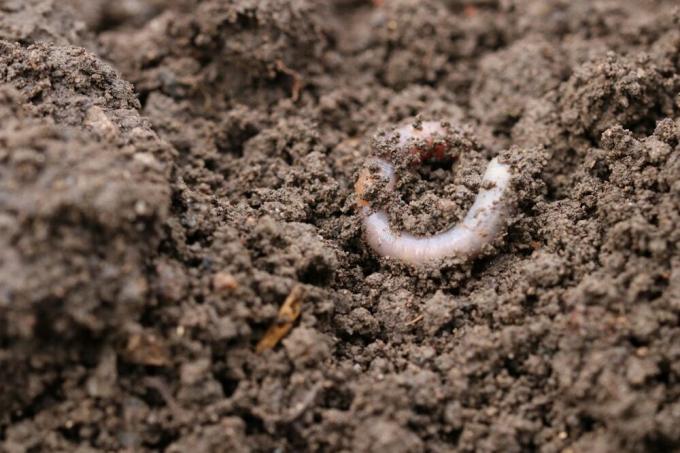
Dampen the earth properly: build your own earth damper | sterilize compost
Sterilizing soil is a common practice that more and more home gardeners are embracing. This allows soil and especially compost to gain optimal quality. The gardening expert explains how to do it correctly and how easy it is to build an earth damper yourself.

Build your own worm box: Instructions | DIY worm composter
Building a worm box yourself is quite easy, but has numerous advantages. In our instructions we show how the DIY worm composter can be made with simple means and in just a few steps.

Build your own composter 12 tips for rain barrels, pallets & garbage cans
A composter is ideal for the garden and balcony. But the numerous options represent a hurdle. Each variant has its advantages. But no matter whether you build your own composter or buy it: there are some aspects that you should consider.

Balcony worm composter: Create compost on the balcony
Gardening is now done in the smallest of spaces, so growing vegetables on the balcony is no longer out of the question. However, a prerequisite for a good harvest is high-quality soil, which can be produced even in a limited space using vermicompost.
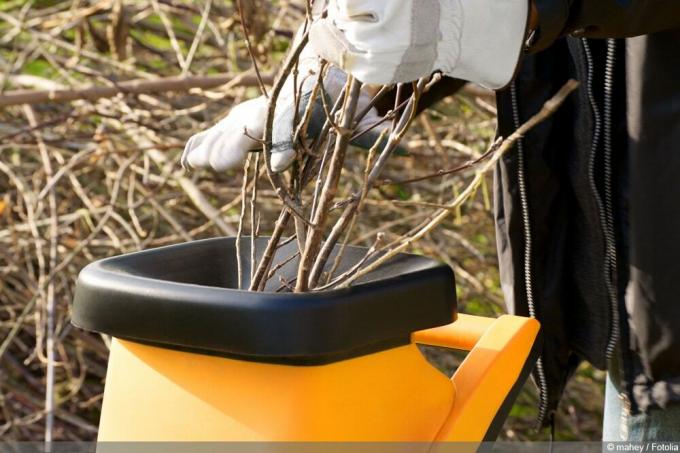
Shredding garden waste and hedge trimmings: which shredder is suitable?
Gardening results in branch cuttings and green waste that can either be disposed of or reused. With a garden shredder, the greens can be processed into compost or mulch and made available for garden use. There are various variants to choose from, which can be adapted to the intended use.

Build a pass-through sieve yourself | Mesh size for compost, soil and sand
In a well-equipped home garden, a pass-through sieve removes unwanted components from compost, soil and sand. With a little manual skill and these instructions, you can easily build a stable garden sieve yourself. You can find out here which mesh size guarantees perfect results.

